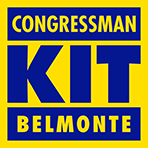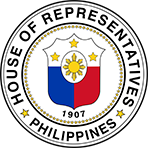Historical Banlat Area Development Plan
Creation of the Historical Banlat Area (HBA)
Office Order No. 91 Series of 2011, signed by Hon. Herbert Bautista, Mayor of Quezon City, created the Banlat Area consisting of several barangays in the second congressional district of the city. The Office Order also established an Action Office whose primary objective is to assist, coordinate andmonitor the Area barangays’ programs, projects and activities, and to promote administrative andtechnical assistance for the planning, organizing and execution of barangay development plans and programs.
The Banlat Area is made up of eleven (11) barangays: Apolonio Samson, Baesa, Balonbato, Culiat, New Era, Pasong Tamo, Sangandaan, Sauyo, Talipapa, Tandang Sora, and Unang Sigaw.
The Banlat Area was later commonly called the Historical Banlat Area (HBA) by the Action Office to highlight a significant and potentially unifying characteristic of the district.
Mandate to prepare an Area Development Plan (ADP)
One of the main activities of the Action Office mandated by the Office Order is the preparation and submission of an Area Development Plan (ADP), including consolidated budget estimates for activities to be undertaken in the Banlat Area.
Methodology used to prepare the Draft ADP
The Action Office, with the assistance of technical staff, gathered data relevant to HBA, which had been consolidated by the City Planning and Development Office (CPDO). Provisions of approved city plans that are relevant to HBA were also extracted and compiled.
Through discussions with the CPDO’s various Divisions, including CPDO consultant Prof. Ernesto Serote, the Action Office generated from the data, as well as the context provided by the city plans, an initial set of development strategies.
The data, the context of the city plans, and the initial set of strategies were presented to the HBA barangay leaders for validation, deepening and expansion in a Consultation-Workshop. Barangay chairpersons, council members and civil society representatives participated in the Consultation- Workshop. Heads and other officers of city Departments also participated.
This Draft of the ADP is a consolidation of the output of the Consultation-Workshop. The data presented in this Draft includes additions provided by the barangay representatives during the Workshop.
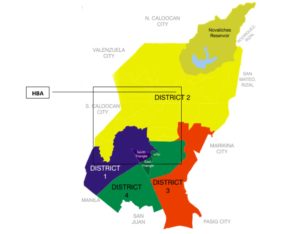
Social Development Sector: Population, Land Area and Density
Based on 2007 NSO figures for population and average annual growth, HBA had a total population of 573,236 in 2011. Sauyo had the biggest population among HBA barangays in 2011, at 105,763. Tandang Sora and Pasong Tamo had the next biggest at more than 90,000 each. Balonbato, Unang Sigaw and New Era had the smallest estimated population at less than 10,000 each. Balonbato had an estimated population of 7,289 for 2011 and the only negative population growth rate in HBA.
HBA comprises about 18% of the population of Quezon City, and close to 5% of the National Capital Region.
HBA accounts for 13.6% of the land area of Quezon City, and 4% of the National Capital Region. Pasong Tamo has the biggest land area among HBA barangays at more than 497 hectares, with Tandang Sora and Sauyo following at 390 and 275 hectares respectively. Unang Sigaw, Balonbato and New Era have the smallest land area, with Unang Sigaw having less than 20 hectares.
HBA has about the same land area as the city of Marikina or Mandaluyong, only slightly smaller than Makati, and is bigger than Malabon, Navotas or Pasay.
Given the figures for population and land area, Sauyo had the highest estimated density in 2011 among the HBA barangays at 383 per hectare, while New Era was the least dense, with 155 per hectare. For the whole of HBA, the average density was 260 persons per hectare in 2011. In comparison, the National Capital Region had an average density of 185 in 2010.
Social Development Sector: Health
Three barangays do not have their own Health Centers. Balonbato and Unang Sigaw are the worst-placed among the HBA barangays in terms of locationally accessible health facilities, having neither a Health Center nor a private hospital in the barangay. New Era also does not have its own functional Health Center but has the New Era General Hospital in its territory.
Baesa and Culiat are currently the only two barangays in HBA with both a Health Center and a private general hospital within their respective barangay boundaries. Two private tertiary hospitals are currently under construction (one each in Pasong Tamo and Talipapa), and Casaul General Hospital in Sangandaan presents possibilities of being re-opened.
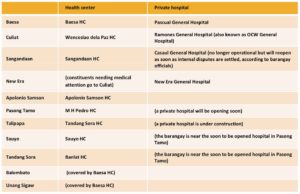
Social Development Sector: Education
There is a severe lack of secondary education facilities in HBA as six (6) barangays (Apolonio Samson,Baesa, Balonbato, Pasong Tamo, Talipapa, and Unang Sigaw do not have public secondary schools within their boundaries. In addition, three (3) barangays (New Era, Sauyo and Tandang Sora) have a deficit of classrooms based on the standard of 1 classroom per 50 children of secondary school age.
On the other hand, Sangandaan and Culiat have a small number of excess classrooms in their respective secondary schools.
All barangays in HBA have public elementary schools but five (5) barangays (Tandang Sora, New Era, Culiat, Pasong Tamo and Sauyo) need more classrooms for their elementary school age population. The rest of the barangays have excess number of elementary school classrooms, with Apolonio Samson having the biggest excess of 9 classrooms.
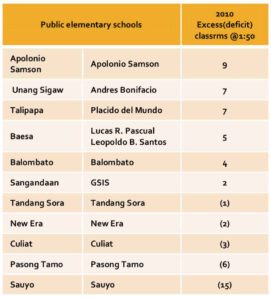

Social Development Sector: Welfare
Pasong Tamo has the most number of day care centers, with eight (8), followed by Baesa with six (6). New Era has no day care center.
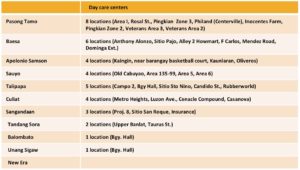
Social Development Sector: Protective Services
Talipapa and Culiat are the best-placed in terms of facilities for protective services, having both police and fire stations or sub-stations within their respective barangay boundaries. Unang Sigaw has no police or fire-fighting facilities, while Balonbato also has no police facility and is still in the process of acquiring a fire truck within 2012.
Six (6) barangays (Apolonio Samson, New Era, Pasong Tamo, Sangandaan, Sauyo, and Tandang Sora) have police stations or sub-stations but no fire sub-station. Three (3) of them however (New Era, Pasong Tamo, Tandang Sora) have some fire-fighting trucks, equipment or personnel.
Baesa has a fire sub-station but no police station or sub-station.
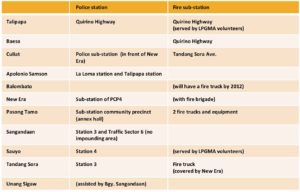
Social Development Sector: Housing
The total number of informal settler families (ISFs) in HBA is estimated at more than 37,000, with Sauyo having the highest number at about 10,000, and Culiat following at close to 10,000 also. New Era has the least number with 15.
About 79% of ISFs are located on private land, and about 12% are on locations considered‘danger areas’.
Government programs to regularize tenure such as Direct Sale and Community Mortgage Program (CMP), as well as programs for relocation have only been able to respond on a scale of hundreds, while the number of ISFs is in the thousands.
Access to sanitation appears to be the worst-served among the basic services to settlements as only two barangays (Baesa and Sangandaan) enjoy some sewerage services from Manila Water Services Inc. (MWSI), the water and sewerage utilities concessionaire for the area.
The HBA barangays have high access to safe drinking water and sanitary toilet, with Balonbato having the lowest access at 85% access to safe drinking and 95% access to sanitary toilet.
Economic Development Sector: Economic Activities
Almost half of licensed economic activity in HBA falls under Wholesale and Retail Trade. Leasing of Real Estate, ICT, and Other Types of Offices is second at about a fifth, and Manufacturing is third with less than a tenth.
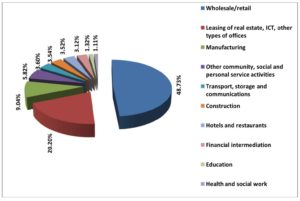
Land Use and Infrastructure: Actual Land Use
Residential uses take up the biggest portion of HBA, at a third of the land area. Vacant land makes up the next biggest portion, at more than 17%, while roads take about 15%. Industrial uses and land occupied by informal settlers take about a tenth each.
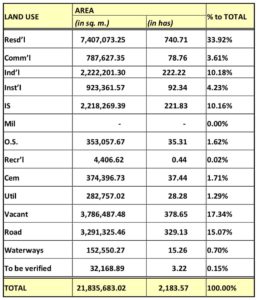
Land Use and Infrastructure: Idle land
Almost 593 hectares of HBA is made up of land parcels, 300 square meters or bigger, that may be considered idle land. Of this idle land, the biggest aggregate area is in Pasong Tamo, which has 212 hectares. Talipapa and Sauyo follow with 118 and 96 hectares respectively.
Five hundred eleven (511) out of these almost 593 hectares of idle land is classified residential. Forty (40) is classified commercial, while 8 is classified industrial.
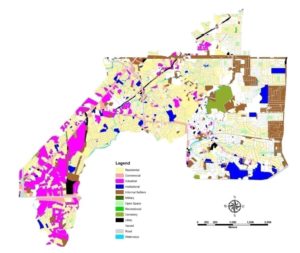
Land Use and Infrastructure: Parks and Open Spaces
HBA has a small number of developed parks and open spaces, with two (2) barangays (Balonbato and New Era) not having even one. There are more areas that have been identified for future development as parks and open spaces. This list of undeveloped parks and open spaces however still does not include any in Balonbato or New Era.
A number of landmarks and areas of historical significance are located in HBA. These are the: Balintawak Monument, the Cloverleaf-Balintawak entry point from the Northern Luzon Expressway (NLEX), the Tandang Sora Shrine, Himlayang Pilipino, and the Iglesia ni Kristo Central Cathedral.
Land Use and Infrastructure: Road Network
Several points in HBA serve as entry points to Quezon City from other cities. These are the Balintawak and Tandang Sora Extension exits to NLEX, and the EDSA thoroughfare to Caloocan.
Other major roads servicing HBA barangays are Quirino Highway, Mindanao Avenue, Tandang Sora Avenue, Congressional Avenue Extension, Visayas Avenue, Central Avenue, Republic Avenue, and Commonwealth Avenue.
Some areas have been identified as traffic-prone. These include: Quirino Highway, particularly at the corners of Mindanao Avenue, Tandang Sora and near NLEX; Tandang Sora corner Visayas Avenue; and EDSA near the Cloverleaf area and at the corner of Kaingin Road.
Environment and Natural Resources: Flood Susceptibility and Flood – Prone Areas
The Landslide and Flood Susceptibility Map of the Mines and Geosciences Bureau (MGB) for the Quezon City Quadrangle shows the areas along the Dario River, as well as the San Francisco River, as highly susceptible to flooding.
The following have also been identified as flood-prone areas: NLEX-Quirino Highway Overpass; EDSA near Cloverleaf; along Tullahan River in Barangays Talipapa and Sauyo; Dario Creek on the boundary of Barangays Tandang Sora and Talipapa; along Culiat Creek; and along San Francisco River in Barangay Apolonio Samson.
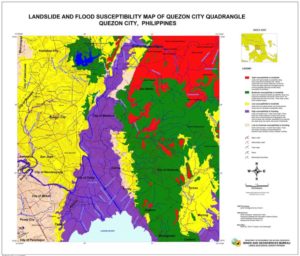
Institutional Development: Barangay Halls
All barangays have their respective physical centers.
Institutional Development: Civil Society Organizations
Baesa has the most number of accredited organizations (11), followed by Culiat, Pasong Tamo and Sauyo with nine (9) each. New Era has none, while Apolonio Samson, Balonbato, Sangandaan, Tandang Sora and Unang Sigaw have one each.
Many of the organizations are homeowners associations (HOAs) or organizations of the urban poor. Other types of organization are those of senior citizens, youth, professionals, business, persons with disabilities (PWDs), academe, and charitable or social justice organizations.
Directions from City Plans
Directions from City Plans: Comprehensive Development Plan (CDP)
The CDP refers to specific proposed interventions in the HBA to address two goals for thecity’s Economic Development sector, and one goal for the Land Use and InfrastructureDevelopment sector.
Directions from City Plans: Economic Development Sector
Under the sector’s Goal 2 (Develop a strong economic environment that will ensure sustained growth), Strategy 5 (Ensure adequate, safe food supply to all residents), one of the programs or projects listed for implementation is the redevelopment of the Cloverleaf area and declared vending sites.
Under Goal 3 (Develop a vibrant economic climate conducive to doing business both for local and foreign investments), Strategy 1 (Develop the city into a globally competitive business center), Balintawak, along with Cubao and Novaliches districts, is one of the possible locations for the program to expand urban renewal projects.
Directions from City Plans: Land Use Infrastructure Development Sector
Under Goal 3 (Provide city inhabitants efficient services and facilities and make the city an attractive place to visit, live, play, work and do business in), Strategy 5 (Provide infrastructure support to different development sectors), various interventions located in HBA are mentioned: construction of by-pass roads, including Mapayapa Village (Sampaguita Avenue) to Visayas Avenue; and construction of road continuity, including Visayas Avenue (Tandang Sora to Republic Avenue) and Republic Avenue (Luzon to Mindanao Avenue).
The redevelopment of the Cloverleaf area and declared vending sites was also listed as a proposed intervention under this goal and strategy.
Comprehensive Land Use Plan (CLUP): Physical Development Challenges
Several physical challenges identified in the CLUP were true for HBA:
– Increase in residential area
– Increase in informal settlements
– Intensification of commercial activities (residential to commercial; commercial 1 or C-1 to commercial 2 or C-2; industrial to commercial)
– Decreasing industrial sector
– Development of special urban development zones (i.e. Balintawak)
– Lack of sites for public schools
The CLUP includes the three (3) biggest barangays of HBA (Sauyo, Pasong Tamo and Tandang Sora), along with the neighboring barangay of Sta. Lucia, in a Type III non-growth or transitional area. This type of land area consists of a collection of land parcels of irregular sizes and shapes, many of which are occupied without clear tenure arrangements. There is serious backlog in the provision of community facilities and services primarily because of difficult external and internal access. Considerable vacant lands still exist. This type of development affects a land area of 1,231 hectares and an estimated population of more than 300,000 in said barangays.
Proposed interventions for this type of growth area include the development f public transport for Congressional Avenue Extension (to decongest Visayas and Tandang Sora Avenues), and improvement of the quality of the physical environment and social development infrastructure.
Comprehensive Land Use Plan (CLUP): Physical Development Challenges
Following a multi-nodal growth strategy for the city, the CLUP identifies the Balintawak- Munoz Area as one of five (5) growth areas of the city. The others are:
– Central Business District (CBD) – Knowledge Community District
– Cubao Growth Center
– National Government Center (NGC) – Batasan Growth Center
– Novaliches – Lagro Growth Area
The Balintawak-Munoz Growth Area includes portions of several barangays not in HBA. It covers 419 hectares, with the entire barangays of Unang Sigaw and Balonbato, and portions of nine (9) other barangays, namely Baesa, Apolonio Samson, Bahay Toro, Ramon Magsaysay, Veterans Village, Katipunan, Masambong, Manresa and Balingasa.
Actual land use of the Balintawak – Munoz Growth Area is 37% industrial, residential 23%, commercial 10%, informal settlers 4%. Proposed interventions for the Growth Area are:
– Find a way to link the northern and southern parts of the growth area which is bisected by EDSA and the LRT North-Monumento Extension
– Develop the northern part as the grand transport modal transfer hub for the termination of all bus lines from areas north of Metro Manila, and the location of the central depot of the MRT 3
– Retain the traditional function of the Cloverleaf-Munoz stretch of EDSA as the food terminal and market for agricultural produce from central and northern Luzon, integrating processing and packaging of agricultural products destined for more sophisticated urban consumer markets
– Determine the feasibility of city-owned and operated abattoir of Triple A rating.
Local Development Investment Program (LDIP)
The City Development Council (CDC) adopted a list of priority projects for the LDIP. Most of them are programs that may be applied city-wide. The top 10 projects identified by the CDC are:
– PhilHealth para sa masa
– Comprehensive barangay/community solid waste management (SWM)
– Socialized housing program
– Upgrading of the Quezon City General Hospital into a Medical Center
– Solid waste disposal system/sanitary landfill
– Rip-rapping along rivers and creeks
– Construction of additional classrooms
– Establishment of modern traffic management system
– Drainage improvement
– Comprehensive disaster risk reduction program
The development of the Balintawak Trading Center through public-private partnership is also on the list of priority projects.
City Shelter Plan
The City Shelter Plan does not propose HBA-specific interventions but specifies goals for the entire city:
– Create a sustainable, safe and secure community where every member is adequately housed, has access to basic services and has opportunity for productivity
– Give priority in providing housing for the low-income groups in economically and environmentally resilient communities
– Encourage and extend support to the initiatives of the private sector in addressing the needs of the middle and high income segments of the population
The strategies to achieve these goals are:
– Increase the supply of affordable housing
– Encourage, develop and promote mixed types of housing tenure, vesting land ownership to the government and giving shelter to the target beneficiaries within their affordability level
– Generate funds for socialized housing
– Improve the people’s access to economic opportunities and capacity to repay
– Sustain community-initiated and self-help projects on housing and community improvement
– Contain and control illegal squatting and growth of informal settlements
Local Tourism Development Plan
Among the goals of the Local Tourism Development Plan, Goal 4 (Develop QC as a hub for culture and the arts) appears to be the most relevant to HBA. The proposed initiatives under this goal are:
– Identify, preserve and promote heritage houses and historical sites
– Calendar predictable events
– Build a cultural center
